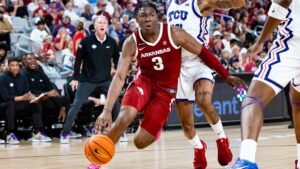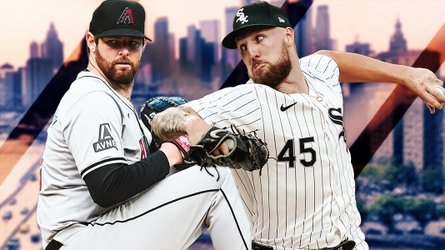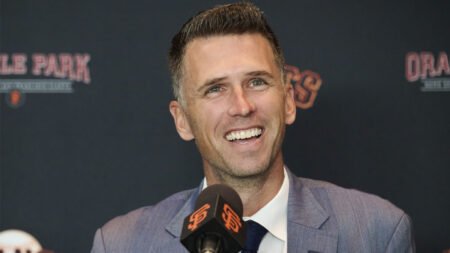Earlier this month at the GM Meetings, Mets president of baseball operations David Stearns made it quite clear that he enjoys the art of trading. That was shown on Tuesday when the Mets acquired outfielder Jose Siri from the Rays in exchange for reliever Eric Orze.
It is an interesting calculation that front offices must make when evaluating player acquisitions. Is it a better idea to just pay player X $15-to-20 million a season? Or is it a better use of resources to trade from your prospect pool and perhaps acquire player Y, who will cost $5-to-10 million a season?
In the Mets’ case with their payroll flexibility, they also have the option to take on bigger salaries from smaller-market teams looking to shed payroll to reduce the prospect capital required.
Although it’s likely that the Mets will do most of their business in free agency this offseason as Stearns works to build on the 2024 team that reached the NLCS, Siri could be just the first of several trades that Stearns executes this winter.
Here are my top five Mets trade targets for this offseason…
5. Diamondbacks LHP Jordan Montgomery
I can remember hearing the constant pleas from Mets fans last offseason about signing Montgomery when he was a free agent. After receiving the qualifying offer, he struggled to develop any kind of market and ended up signing with the Diamondbacks deep into spring training for one year with a player option for 2025.
Montgomery had probably the toughest year of his big league career in 2024, posting a 6.23 ERA in 117 innings across 25 appearances. He ended up being shifted to the bullpen due to his struggles. This led to Ken Kendrick, the owner of the D-backs, referring to signing Montgomery as a “horrible decision.”
Montgomery opted into his $22.5 million player option and there is strong belief that he will not throw another pitch for Arizona. The Diamondbacks will likely need to eat money or take back another team’s unwanted salary to convince someone to take him.
This would be the Mets buying low on a distressed asset. Montgomery would be pitching in 2025 at 32 years old. Despite his poor 2024, he has been a consistent innings-eater with proven playoff success. One evaluator I spoke to thought Montgomery could be in for a better 2025 with a normal offseason and spring training.
As the Mets evaluate back-end rotation options, taking a flier on Montgomery — likely at a reduced financial and prospect cost — could prove to be a savvy addition if he can regain anything remotely close to the form that he had in 2023, when he posted a 3.20 ERA in 188.2 innings split between the Cardinals and the World Series Champion Rangers.
4. Cardinals 3B Nolan Arenado
One situation that can transpire this winter is Pete Alonso leaving the Mets. If that does occur, the Mets will have decisions to make. Do they pursue a first baseman like Christian Walker or Paul Goldschmidt? Do they shift Mark Vientos to first base and pursue a third baseman?
There’s no way around it — the 33-year-old Arenado’s offense has trended backwards the last couple of years. His OPS was .891 in 2022, .774 in 2023 and .719 in 2024, with his home run power notably taking the biggest dive in 2024 as it dropped down to 16. However, it is worthwhile to note both his batting average and on-base percentage were better in 2024 than 2023 and he still is elite at making contact (88th percentile whiff percentage) and avoiding strikeouts (92nd percentile strikeout percentage).
Defensively, Arenado is still elite and Gold Glove-caliber, grading out at 10 Outs Above Average, which put him in the 95th percentile.
Now for the dollars discussion. Arenado will make $74 million over the next three seasons, though he counts for an even $30.5 million annually against the luxury tax payroll due to that number being purely the average annual value of the contract. That $30.5 million number is reduced to $25.5 million for the next two seasons due to the Rockies agreeing to pay $5 million per year of his salary through 2026 as part of the trade that sent Arenado to St. Louis.
Independently, the Mets could look at Arenado as a bounce-back candidate offensively with a plus glove at the hot corner. As I noted above, they could potentially offer to take on a good chunk or all of Arenado’s remaining dollars to acquire someone like Ryan Helsley at a lower cost in prospect capital.
3. Cardinals RHP Ryan Helsley
With the Cardinals trending towards a near full-blown rebuild, Helsley is a reliever that people in league circles believe will be available this winter. It has nothing to do with his talent, as he is one of the better relievers in the sport. Rather, it’s because he is under contractual control for only one more season at a projected $6.9 million in his last year of arbitration.
Helsley posted a 2.04 ERA in 66.1 relief innings last season, striking out 79 and saving 49 games for the 83-win Cardinals. He throws almost exclusively two pitches: a gyro slider that averaged 89.2 mph (thrown 48 percent of the time) and his four-seam fastball averaging 99.6 mph (thrown 45 percent of the time).
The cost will not be cheap here by way of prospects, though the Mets can potentially reduce the cost by taking on Arenado. If the Mets are looking to acquire Helsley independently, it likely would cost them at least one prospect ranked in their top 10 and another piece. The Mets have a pretty large need for another reliable back-end bullpen arm, and they likely could not do much better on the market this winter than Helsley.
2. Mariners RHP Luis Castillo
The Mariners are openly looking for offense at second and third base and have an abundance of starting pitching with Castillo, Logan Gilbert, George Kirby, Bryce Miller, and Bryan Woo, along with other options behind them. Castillo could be available due to being the most expensive of the group, making $24.1 million ($21.6 million for luxury tax purposes) per year through 2027 with a vesting option for 2028.
Castillo is probably more of a good No. 3 starter who you can rely on for innings and some swing-and-miss than the frontline starter he was a couple of years ago. In 2024, he posted a 3.64 ERA in 30 starts, having his year cut short when he went on the IL in September with a hamstring strain. In 175.1 innings, he struck out 175 batters.
He still throws hard, averaging 95.6 mph on his fastball, but his average fastball velocity has decreased the last couple of years (97.1 mph in 2022 and 96.3 mph in 2023). Despite the velocity dip, it has still been an effective offering as he allowed just a .203 batting average against it in 2024. He also throws a slider, sinker and changeup. One notable difference with Castillo is if you go back to 2021, his changeup was his most used pitch, and over the last two seasons it has become his least used pitch — and batters hit .287 against it in 2024.
This certainly would not be a salary dump situation, but this could potentially be an opportunity where the Mets can send back some money like Jeff McNeil’s $12.5 million luxury tax figure the next two seasons in addition to a prospect or two. This could be a move to land needed rotation help at a net rise of $9.1 million in luxury tax payroll per year over the next two years, while the Mets would take on the $21.6 million salary in 2027 and the vesting option in 2028.
1. White Sox LHP Garrett Crochet
The Mets are looking to add impact to their starting rotation and Crochet is likely to top the list of available arms on the trade market. The 25-year-old converted reliever just finished his first full season as a starter, posting a 3.58 ERA in 32 starts. In 146 innings he allowed only 123 hits and 33 walks while striking out a whopping 209 batters. His expected stats (2.85 xERA and 2.69 FIP) suggest his ERA should have been much better than it was. One factor that it can be tied to is the White Sox defense, which ranked 27th in the league in defensive runs saved.
Standing at 6-foot-6 and 245 pounds, Crochet possesses elite extension at 7.1 feet, which means when he releases the ball, he is 53 feet away from the hitter instead of the 60 feet that is the pitching rubber. He has a five-pitch mix headlined by a four-seam fastball that averaged 97.1 mph and will touch 100-101 mph, along with a cutter, sweeper, changeup, and a sinker he debuted in August that ended up being his third-most utilized pitch by September, averaging 98 mph.
Adding to his value is the fact that he is projected to make $3 million in 2025 through arbitration and is under contractual control through the 2026 season. It has also been reported dating back to the trade deadline that he would be amenable to a long-term contract if a new team acquires him.
Crochet does not come without questions or concerns. He was a college reliever and started his professional career as one as well. He underwent Tommy John surgery in 2022 and dealt with shoulder inflammation in 2023, which limited him to 12.2 innings of relief. His limited innings in his career can be looked at one of two ways. One one hand, he has a lot of innings left in his arm, but the other side of the coin is questioning if his arm can handle the workload.
With the cost of starting pitching in the current market, teams are going to look past some of the questions and believe with their pitching coaches, sports science, and analytics departments that they will be able to help Crochet be successful — and more importantly, healthy.
This means the White Sox can have a high asking price. Their general manager Chris Getz openly said at the GM Meetings that he’d target position players in a potential Crochet deal. The Mets do have those available, almost in excess.
Would they be able to make a deal without Jett Williams? Do the White Sox value truly major league ready options they can stick in their lineup on Opening Day like Ronny Mauricio, Luisangel Acuña, and Brett Baty? Do they desire potential sluggers like Ryan Clifford or Jesus Baez?
The Mets will face stiff competition in the Crochet market, likely from teams like the Red Sox, who possess four hitting prospects ranked inside of the top 25 of MLB Pipeline’s Top 100, and the Orioles. This is an opportunity to land a potential frontline starter at a small financial cost, albeit likely at a high prospect cost.
Read the full article here














